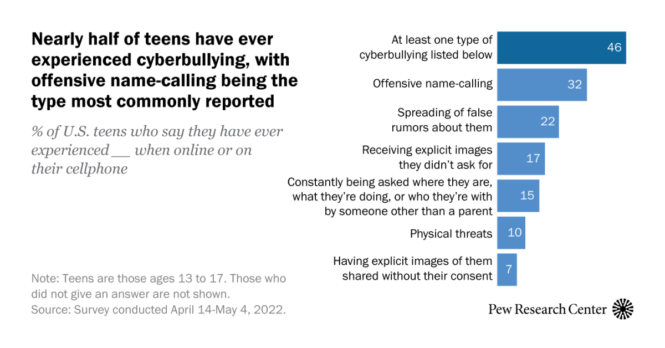
Virtually fifty percent of united state teenagers have actually been harassed or bothered online, with physical look being viewed as a reasonably usual reason. Older teen women are specifically most likely to report being targeted by online misuse total and also due to their look
Bench Proving ground performed this research to much better comprehend teenagers’ experiences with and also sights on intimidation and also harassment online. For this evaluation, we checked 1,316 united state teenagers. The study was carried out on-line by Ipsos from April 14 to Might 4, 2022.
This research study was evaluated and also accepted by an exterior institutional testimonial board (IRB), Advarra, which is an independent board of professionals that concentrates on aiding to shield the legal rights of research study individuals.
Ipsos hired the teenagers by means of their moms and dads that belonged of its KnowledgePanel, a probability-based internet panel hired largely with nationwide, arbitrary tasting of household addresses. The study is weighted to be depictive of united state teenagers ages 13 to 17 that deal with moms and dads by age, sex, race, ethnic background, house earnings and also various other classifications.
Right Here are the concerns utilized for this record, in addition to actions, and also its method.
While harassing existed long prior to the web, the increase of mobile phones and also social media sites has actually brought a brand-new and also much more public field right into bet this hostile actions.
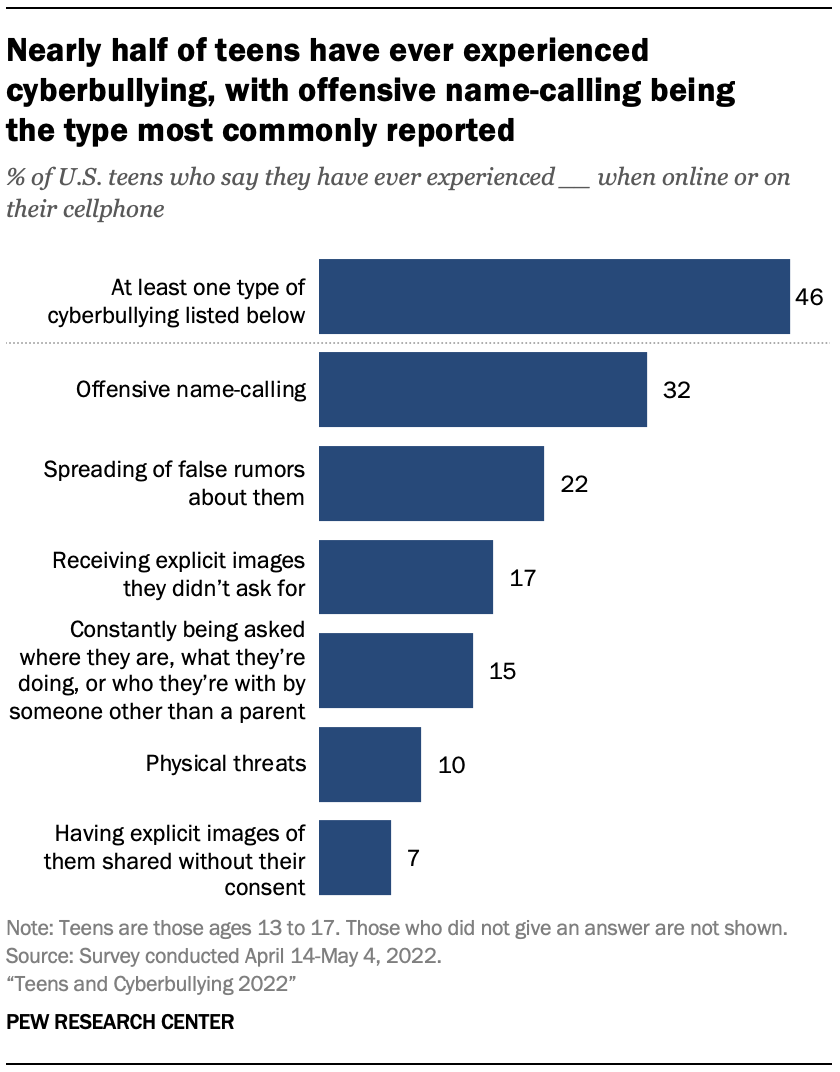
Virtually fifty percent of united state teenagers ages 13 to 17 (46%) record ever before experiencing a minimum of among 6 cyberbullying actions inquired about in a Church bench Proving ground study carried out April 14-May 4, 2022.
One of the most typically reported actions in this study is name-calling, with 32% of teenagers stating they have actually been called an offending name online or on their cellular phone. Smaller sized shares claim they have actually had incorrect reports spread out regarding them on-line (22%) or have actually been sent out specific photos they really did not request (17%).
Some 15% of teenagers claim they have actually experienced somebody aside from a moms and dad continuously inquiring where they are, what they’re doing or that they’re with, while 10% claim they have actually been literally intimidated and also 7% of teenagers claim they have actually had specific photos of them shared without their authorization.
In total amount, 28% of teenagers have actually experienced numerous kinds of cyberbullying.
Specifying cyberbullying in this record
This record gauges cyberbullying of teenagers utilizing 6 distinctive actions:
- Offending name-calling
- Dispersing of incorrect reports regarding them
- Obtaining specific photos they really did not request
- Physical risks
- Frequently being asked where they are, what they’re doing, or that they’re with by somebody aside from a moms and dad
- Having specific photos of them shared without their authorization
Teenagers that show they have actually directly experienced any one of these actions online or while utilizing their cellular phone are taken into consideration targets of cyberbullying in this record. The terms “cyberbullying” and also “on-line harassment” are utilized mutually throughout this record.
Age and also sex belong to teenagers’ cyberbullying experiences, with older teen women being specifically most likely to encounter this misuse
Teenagers’ experiences with online harassment differ by age. Some 49% of 15- to 17-year-olds have actually experienced a minimum of among the 6 on-line actions, compared to 42% of those ages 13 to 14. While comparable shares of older and also more youthful teenagers report being the target of name-calling or report dispersing, older teenagers are most likely than their more youthful equivalents (22% vs. 11%) to claim somebody has actually sent them specific photos they really did not request, an act often described as cyberflashing; had somebody share specific photos of them without their authorization, in what is additionally referred to as vengeance pornography (8% vs. 4%); or been the target of relentless examining regarding their location and also tasks (17% vs. 12%).
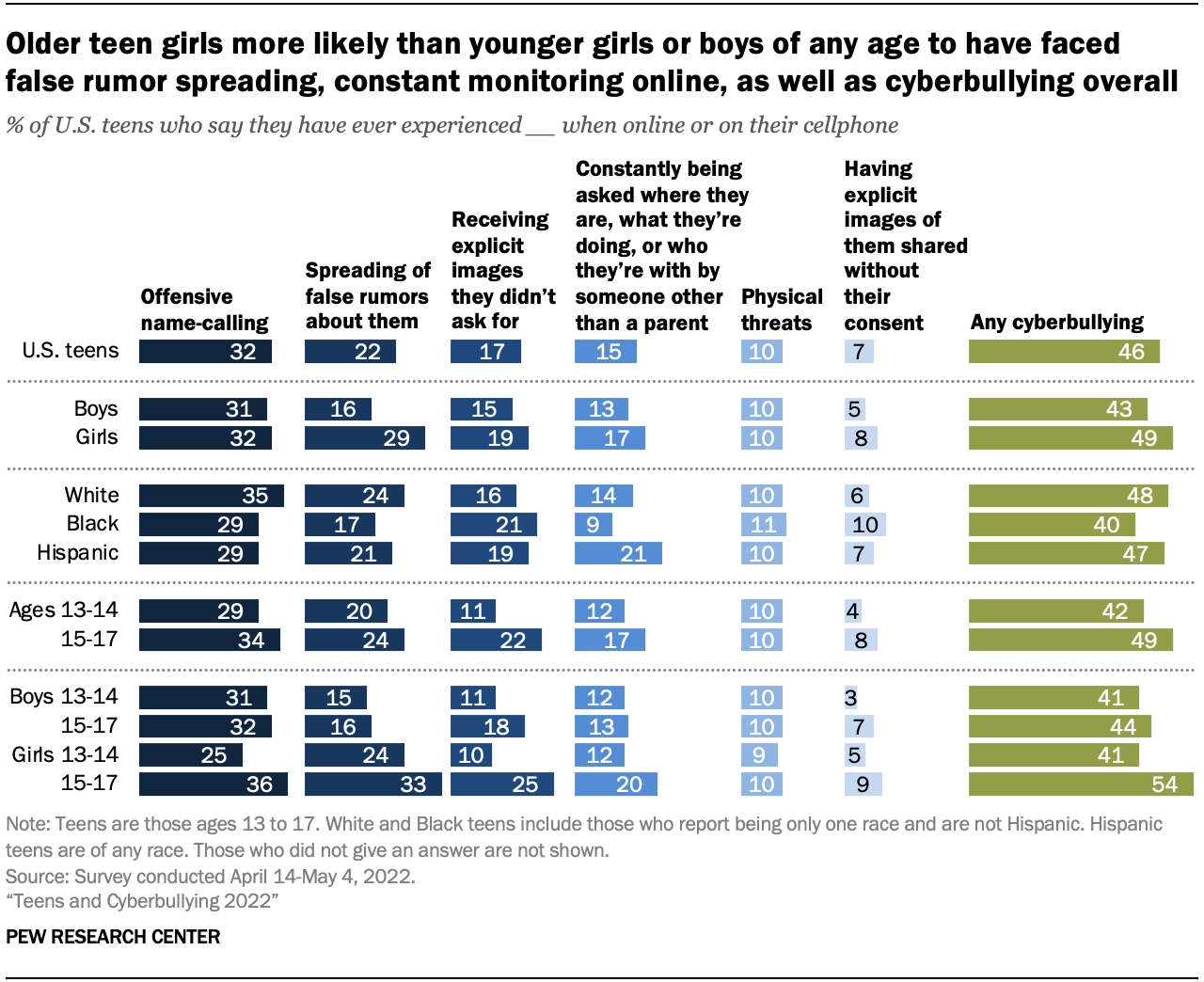
While there is no sex distinction in having ever before skilled online misuse, teen women are most likely than teen young boys to claim incorrect reports have actually been spread out regarding them. However better distinctions are seen when taking a look at age and also sex with each other: 15- to 17-year-old women stand apart for being especially most likely to have actually dealt with any type of cyberbullying, compared to more youthful teen women and also teenager young boys of any type of age. Some 54% of women ages 15 to 17 have actually experienced a minimum of among the 6 cyberbullying actions, while 44% of 15- to 17-year-old young boys and also 41% of young boys and also women ages 13 to 14 claim the very same. These older teen women are additionally most likely than more youthful teen women and also teenager young boys of any type of age to report being the target of incorrect reports and also continuous tracking by somebody aside from a moms and dad.
White, Black and also Hispanic teenagers do not statistically vary in having actually ever before been bothered online, yet certain kinds of on-line assaults are much more common amongst specific teams. As an example, White teenagers are most likely to report being targeted by incorrect reports than Black teenagers. Hispanic teenagers are most likely than White or Black teenagers to claim they have actually been asked continuously where they are, what they’re doing or that they’re with by somebody aside from a moms and dad.
There are additionally distinctions by house earnings when it pertains to physical risks. Teenagers that are from houses earning less than $30,000 every year are two times as most likely as teenagers residing in houses making $75,000 or even more a year to claim they have actually been literally intimidated online (16% vs. 8%).
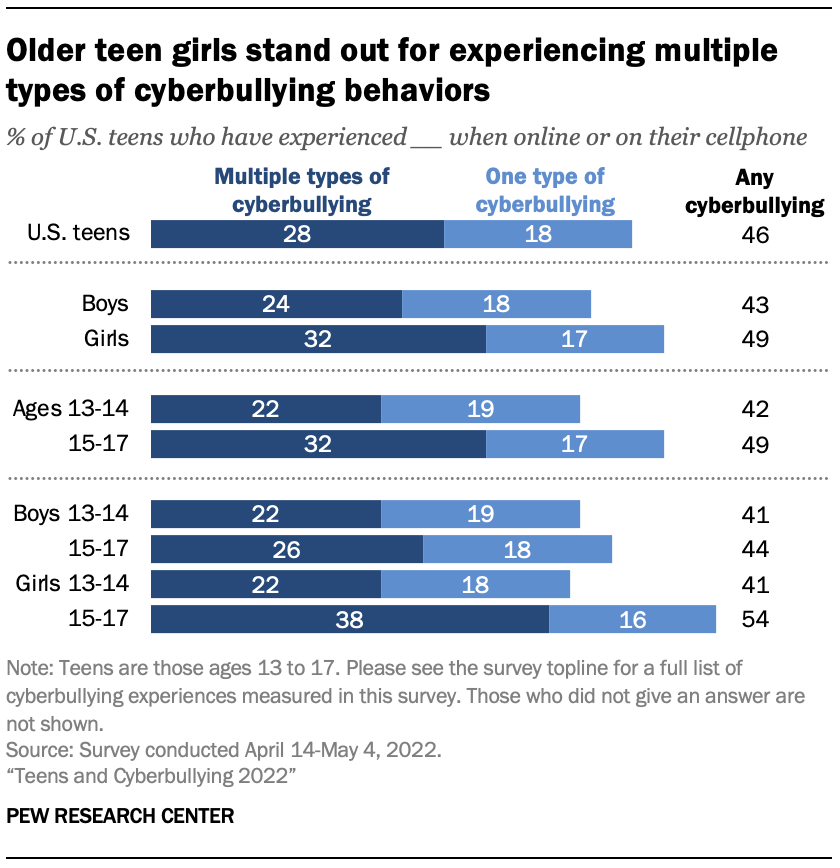
Past those distinctions connected to certain pestering actions, older teen women are especially most likely to claim they experience numerous kinds of online harassment. Some 32% of teen women have actually experienced 2 or even more kinds of online harassment inquired about in this study, while 24% of teenager young boys claim the very same. As well as 15- to 17-year-olds are most likely than 13- to 14-year-olds to have actually been the target of numerous kinds of cyberbullying (32% vs. 22%).
These distinctions are greatly driven by older teen women: 38% of teen women ages 15 to 17 have actually experienced a minimum of 2 of the pestering actions inquired about in this study, while approximately a quarter of more youthful teen women and also teenager young boys of any type of age claim the very same.
Past market distinctions, being the target of these actions and also encountering numerous kinds of these actions additionally differ by the quantity of time young people invest online. Teenagers that claim they are on-line practically continuously are not just most likely to have actually ever before been bothered on-line than those that report being on-line much less commonly (53% vs 40%), yet are additionally most likely to have actually dealt with numerous types of on-line misuse (37% vs. 21%).
These are several of the searchings for from a Church bench Proving ground online study of 1,316 united state teenagers carried out from April 14 to Might 4, 2022.
Black teenagers have to do with two times as most likely as Hispanic or White teenagers to claim they believe their race or ethnic background made them a target of on-line misuse
There are countless reasons that a teenager might be targeted with online misuse. This study asked young people if they thought their physical look, sex, race or ethnic background, sexual preference or political sights were a consider them being the target of violent actions online.
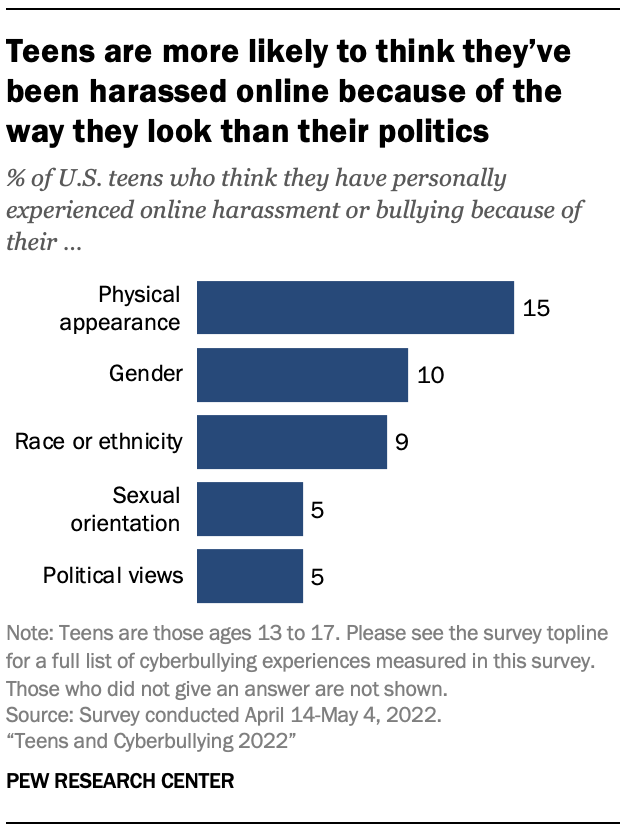
Teenagers are more than likely to claim their physical look made them the target of cyberbullying. Some 15% of all teenagers believe they were cyberbullied due to their look.
Regarding one-in-ten teenagers claim they were targeted due to their sex (10%) or their race or ethnic background (9%). Teenagers much less typically report being bothered for their sexual preference or their political sights– simply 5% each.
Considering these numbers differently, 31% of teenagers that have directly skilled online harassment or intimidation believe they were targeted due to their physical look. Regarding one-in-five cyberbullied teenagers claim they were targeted as a result of their sex (22%) or their racial or ethnic history (20%). As well as approximately one-in-ten influenced teenagers indicate their sexual preference (12%) or their political sights (11%) as a reason that they were targeted with harassment or harassing online.
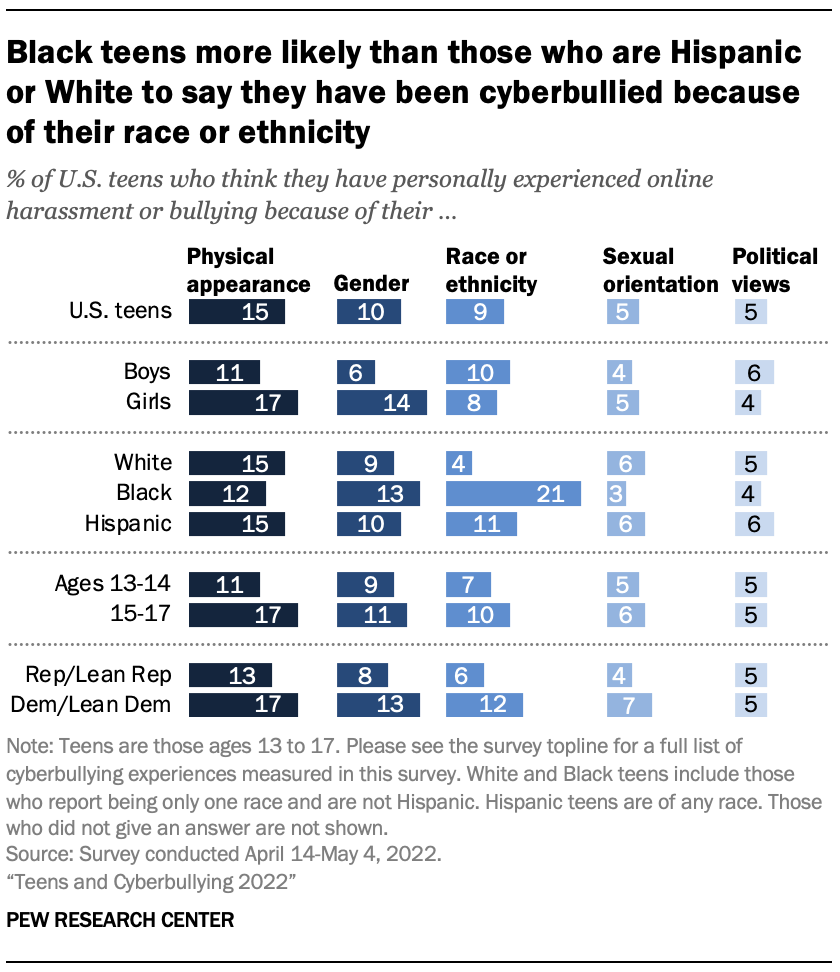
The factors teenagers mention for why they were targeted for cyberbullying are greatly comparable throughout significant market teams, yet there are a couple of essential distinctions. As an example, teen women total are most likely than teen young boys to claim they have actually been cyberbullied due to their physical look (17% vs. 11%) or their sex (14% vs. 6%). Older teenagers are additionally most likely to claim they have actually been bothered on-line due to their look: 17% of 15- to 17-year-olds have actually experienced cyberbullying due to their physical look, compared to 11% of teenagers ages 13 to 14.
Older teen women are especially most likely to believe they have actually been bothered on-line due to their physical look: 21% of all 15- to 17-year-old women believe they have actually been targeted because of this. This compares to around one-in-ten more youthful teen women or teen young boys, no matter age, that believe they have actually been cyberbullied due to their look.
A teenager’s racial or ethnic history associates with whether they report having actually been targeted for cyberbullying due to race or ethnic background. Some 21% of Black teenagers report being made a target due to their race or ethnic background, compared to 11% of Hispanic teenagers and also an also smaller sized share of White teenagers (4%).
There are no partial distinctions in teenagers being targeted for their political sights, with 5% of those that determine as either Autonomous or Republican– consisting of those that favor each celebration– stating they believe their political sights added to them being cyberbullied.
Black or Hispanic teenagers are most likely than White teenagers to claim cyberbullying is a significant trouble for individuals their age
Along with determining teenagers’ very own individual experiences with cyberbullying, the study additionally looked for to comprehend youngsters’s sights regarding on-line harassment much more normally.
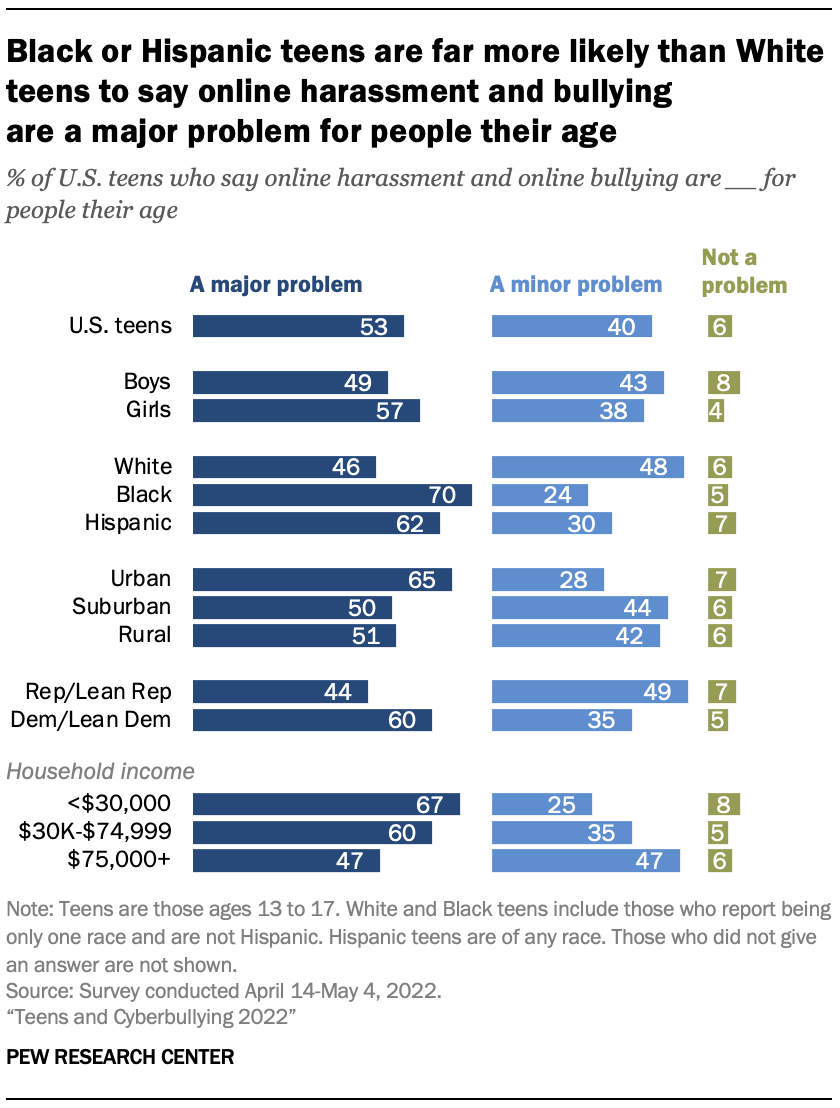
The substantial bulk of teenagers claim on-line harassment and also on-line intimidation are an issue for individuals their age, with 53% stating they are a significant trouble. Simply 6% of teenagers believe they are not an issue.
Particular market teams stand apart for just how much of an issue they claim cyberbullying is. Seven-in-ten Black teenagers and also 62% of Hispanic teenagers claim on-line harassment and also intimidation are a significant trouble for individuals their age, compared to 46% of White teenagers. Teenagers from houses making under $75,000 a year are likewise inclined to call this sort of harassment a significant trouble, with 62% making this case, compared to 47% of teenagers from even more upscale residences. Teenager women are additionally most likely than young boys to check out cyberbullying as a significant trouble.
Sights additionally differ by neighborhood kind. Some 65% of teenagers residing in city locations claim on-line harassment and also intimidation are a significant trouble for individuals their age, compared to regarding fifty percent of rural and also country teenagers.
Partial distinctions look like well: Six-in-ten Autonomous teenagers claim this is a significant trouble for individuals their age, compared to 44% of Republican teenagers stating this.
In recent times, there have actually been a number of efforts and also programs focused on stopping negative actions online, yet teenagers mostly sight several of those behind these initiatives– consisting of social media sites firms and also political leaders– in a distinctly unfavorable light.
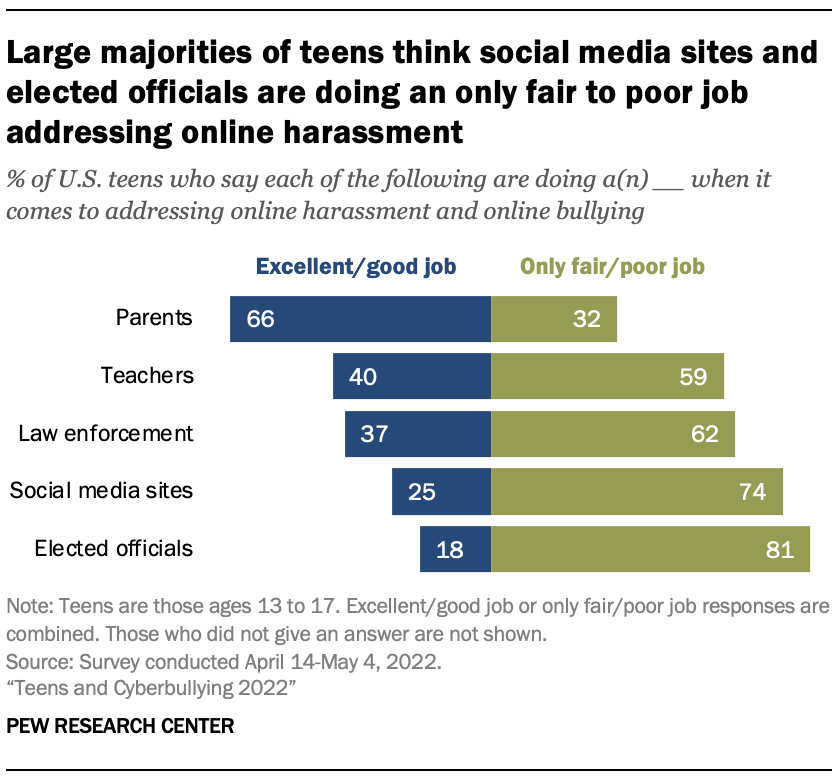
According to teenagers, moms and dads are doing the very best of the 5 teams inquired about in regards to attending to on-line harassment and also on-line intimidation, with 66% of teenagers stating moms and dads are doing a minimum of an excellent work, consisting of one-in-five stating it is an outstanding work. About four-in-ten teenagers report believing instructors (40%) or police (37%) are doing an excellent or exceptional work attending to on-line misuse. A quarter of teenagers claim social media sites websites are doing a minimum of an excellent work attending to on-line harassment and also cyberbullying, and also simply 18% claim the very same of chosen authorities. Actually, 44% of teenagers claim chosen authorities have actually done a bad work attending to on-line harassment and also on-line intimidation.
Teenagers that have actually been cyberbullied are much more important of just how numerous teams have actually resolved on-line intimidation than those that have not
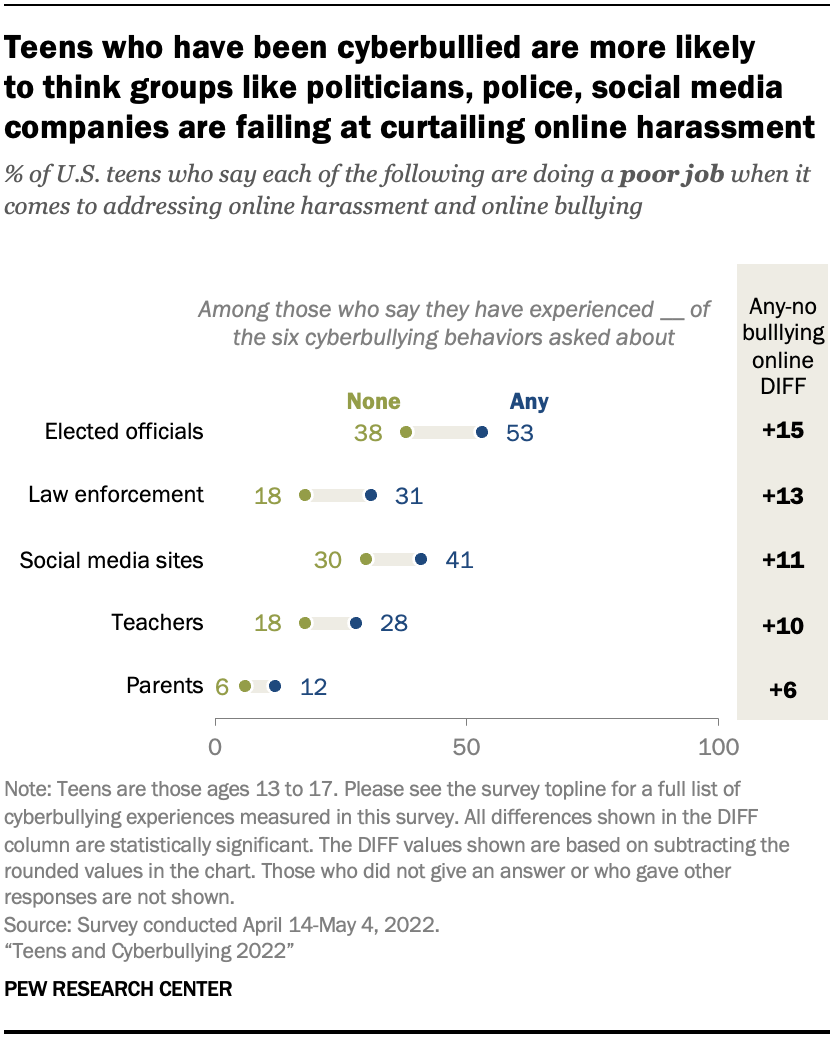
Teenagers that have actually experienced harassment or harassing online have a really various viewpoint on just how numerous teams have actually been taking care of cyberbullying compared to those that have actually not encountered this sort of misuse. Some 53% of teenagers that have actually been cyberbullied claim chosen authorities have actually done a bad work when it pertains to attending to on-line harassment and also on-line intimidation, while 38% that have actually not undertaken these experiences claim the very same (a 15 percent factor space). Double-digit distinctions additionally show up in between teenagers that have and also have actually not been cyberbullied in their sights on just how police, social media sites websites and also instructors have actually resolved on-line misuse, with teenagers that have actually been bothered or harassed online being much more important of each of these 3 teams. These bothered teenagers are additionally two times as most likely as their peers that report no misuse to claim moms and dads have actually done a bad work of battling on-line harassment and also intimidation.
Apart from these distinctions based upon individual experience with cyberbullying, just a few distinctions are seen throughout significant market teams. As an example, Black teenagers reveal better resentment than White teenagers regarding just how police has actually made out in this area: 33% of Black teenagers claim police is doing a bad work when it pertains to attending to on-line harassment and also on-line intimidation; 21% of White teenagers claim the very same. Hispanic teenagers (25%) do not vary from either team on this concern.
Teenagers have differing sights regarding feasible activities that might aid to suppress the quantity of online harassment young people experience on social media sites.
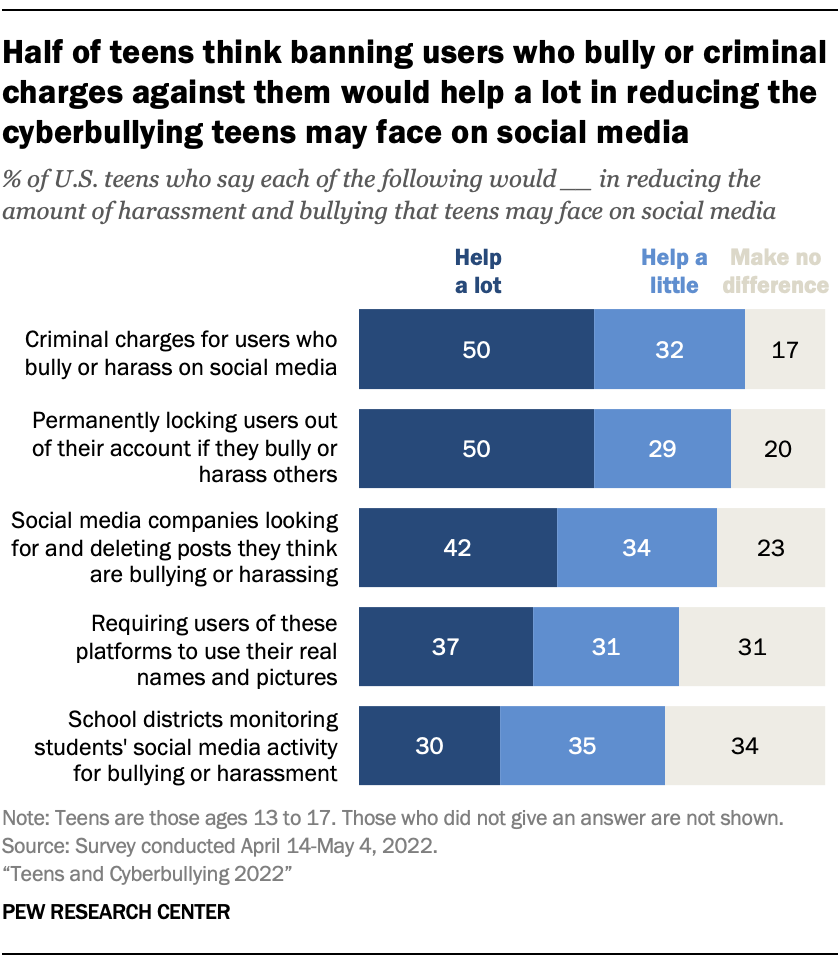
While a bulk of teenagers claim each of 5 feasible remedies inquired about in the study would certainly a minimum of aid a little, specific actions are considered as being much more efficient than others.
Teenagers see one of the most profit in criminal costs for customers that bully or bug on social media sites or completely securing these customers out of their account. Fifty percent of teenagers claim each of these choices would certainly aid a whole lot in minimizing the quantity of harassment and also harassing teenagers might encounter on social media sites websites.
Regarding four-in-ten teenagers believe that if social media sites firms searched for and also erased articles they believe are harassing or pestering (42%) or if customers of these systems were needed to utilize their actual names and also photos (37%) it would certainly aid a whole lot in attending to these problems. The suggestion of compeling individuals to utilize their actual name while online has actually long existed and also been greatly questioned: Advocates see it as a means to hold criminals responsible and also maintain on-line discussions much more civil, while critics think it would certainly do little to fix harassment and also might also intensify it.
Three-in-ten teenagers claim institution areas keeping track of trainees’ social media sites task for harassing or harassment would certainly aid a whole lot. Some institution areas currently utilize electronic tracking software application to aid them determine fretting trainee actions on school-owned gadgets, social media sites and also various other on-line systems. Nevertheless, these programs have actually been met objection relating to personal privacy problems, combined outcomes and also whether they do even more injury than excellent.
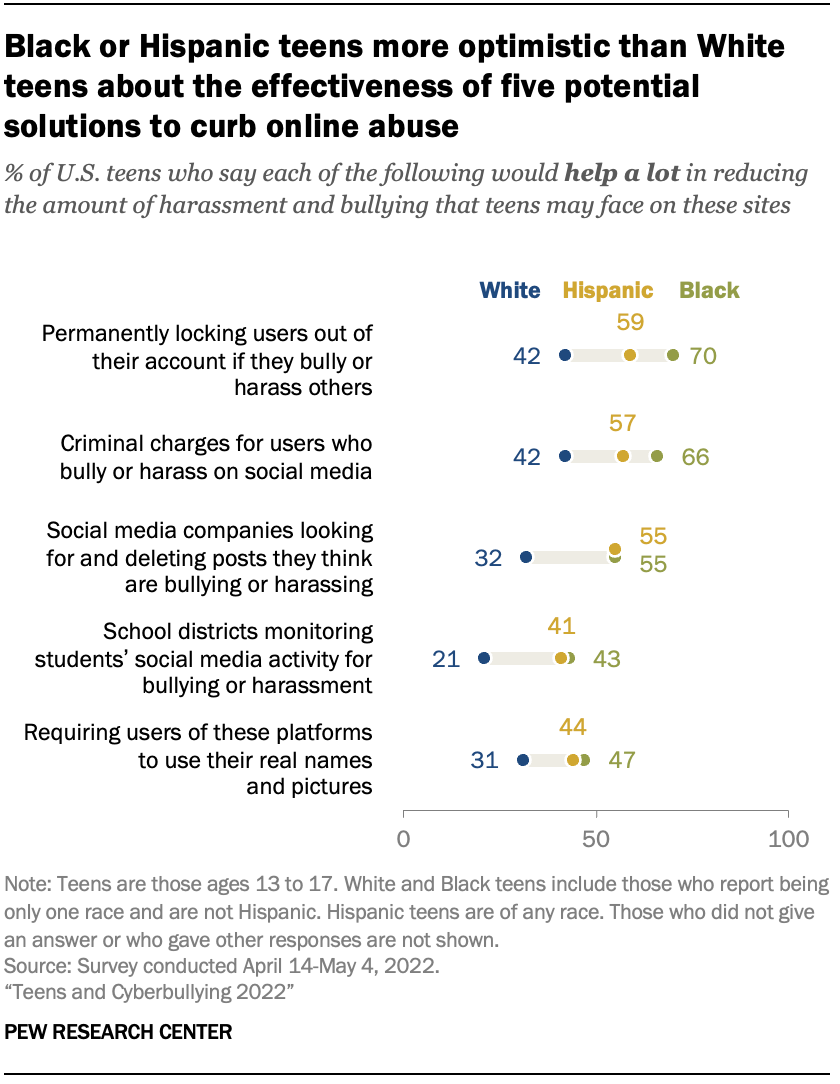
Having directly skilled online harassment is unconnected to a teenager’s sight on whether these prospective actions would certainly aid a whole lot in minimizing these kinds of damaging experiences on social media sites. Sights do differ commonly by a teenager’s racial or ethnic history, nonetheless.
Black or Hispanic teenagers are continually much more positive than White teenagers regarding the efficiency of each of these actions.
Bulks of both Black and also Hispanic teenagers claim completely securing customers out of their account if they bully or bug others or criminal costs for customers that bully or bug on social media sites would certainly aid a whole lot, while regarding four-in-ten White teenagers reveal each sight.
When it comes to long-term restrictions, Black teenagers better stand apart from their Hispanic peers: Seven-in-ten claim this would certainly aid a whole lot, complied with by 59% of Hispanic teenagers and also 42% of White teenagers.
